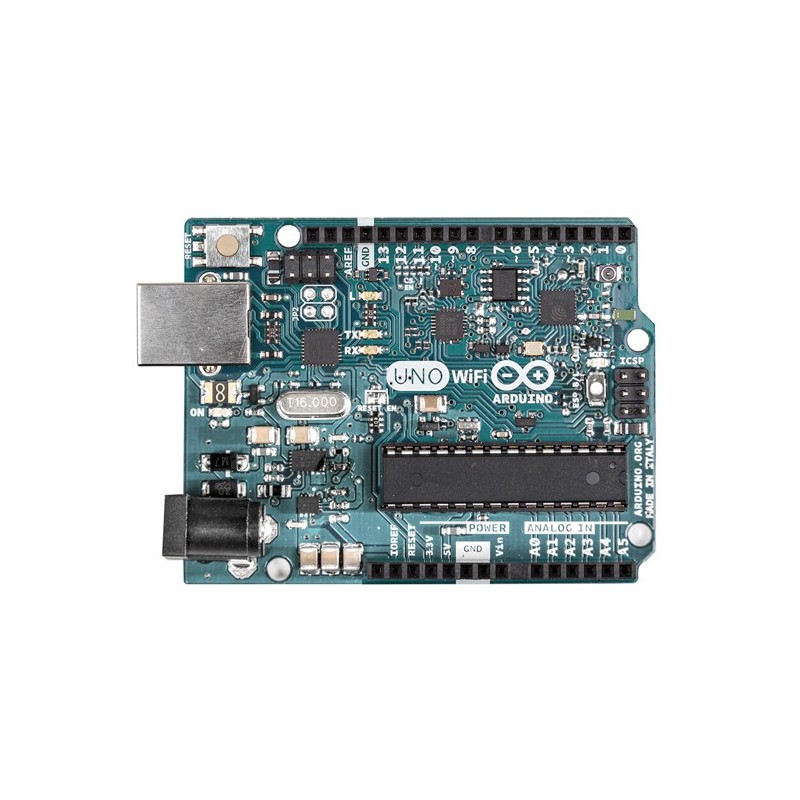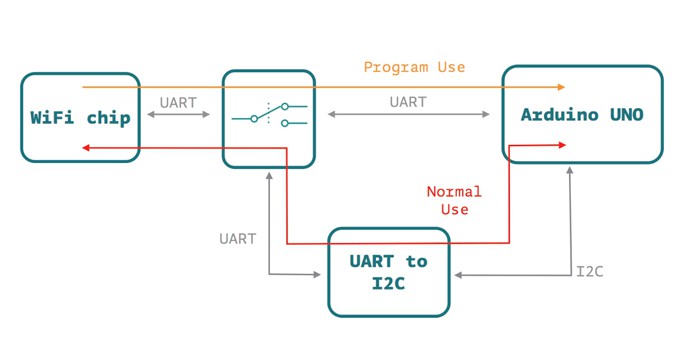- Out-of-Stock

The Arduino Uno Wi-Fi is the new Arduino Uno with an integrated Wi-Fi module! The board is based on the ATmega328P (datasheet) with an ESP8266 Wi-Fi Module integrated (datasheet). It has 14 digital input/output pins (of which 6 can be used as PWM outputs), 6 analog inputs, a 16 MHz ceramic resonator, a USB connection, a power jack, an ICSP header, and a reset button. It contains everything needed to support the microcontroller; simply connect it to a computer with a USB cable or power it with an AC-to-DC adapter or battery to get started.
The ESP8266 Wi-Fi Module is a self contained SoC with integrated TCP/IP protocol stack that can give access to your Wi-Fi network. (Or the device can act as an access point.) One useful feature of Uno Wi-Fi is support for OTA (over-the-air) programming, either for transfer of Arduino sketches or Wi-Fi firmware.
Power
Memory
Input and Output
Communication
The Arduino Uno Wi-Fi has a number of facilities for communicating with a computer, another Arduino, or other microcontrollers. The ATmega328 provides UART TTL (5V) serial communication, which is available on digital pins 0 (RX) and 1 (TX). An ATmega16U2 on the board channels this serial communication over USB and appears as a virtual com port to software on the computer. The 16U2 firmware uses the standard USB COM drivers, and no external driver is needed. However, on Windows, a .inf file is required. The Arduino software includes a serial monitor which allows simple textual data to be sent to and from the Arduino board. The RX and TX LEDs on the board will flash when data is being transmitted via the USB-to-serial chip and USB connection to the computer (but not for serial communication on pins 0 and 1).
A SoftwareSerial library allows for serial communication on any of the Uno's digital pins.
The ATmega328 also supports I2C (TWI) and SPI communication. The Arduino software includes a Wire library to simplify use of the I2C bus; For SPI communication, use the SPI library.
On the Arduino Uno Wi-Fi there’s a SC16IS750IBS IO Expander Single UART with I2C-bus/SPI interface that allows the communication between AtMega 16u2, AtMega 328p and the ESP8266EX.

The Arduino Uno Wi-Fi allow you to communicate via Wi-Fi with your sensors or actuators mounted on your board to create easily and quickly your IoT System. You can use your Arduino Uno Wi-Fi as a client of your Wi-Fi network, as a server to connect other client devices or you can create an ad’hoc Wi-Fi connection.
The perfect way to communicate to internet via your Arduino Uno Wi-Fi is the Ciao Library and using, for example, the REST connector.
On the Arduino Uno Wi-Fi is pre-uploaded the RestServer sketch that allows you to command immediately your board via browser:
Connect to the Arduino Uno Wi-Fi SSID and go to the link http://192.168.240.1/arduino/digital/13/1 to turn ON the LED L
Here other possible commands:
Arduino Microcontroller Features
Microprocessor ESP8266
Manufacturer BTC Korporacja sp. z o. o. Lwowska 5 05-120 Legionowo Poland sprzedaz@kamami.pl 22 767 36 20
No product available!
Digital Proximity, Ambient Light, RGB and Gesture Sensor, Avago Technologies, RoHS
No product available!
No product available!
No product available!
Andrew Vladimirov, Konstantin V. Gavrilenko, Andrei A. Mikhailovsky
No product available!
Tracer Zelih Duo black optical mouse with nanorangeor, 3 buttons. TRAMYS44904
No product available!
Gate driver in uWiFi technology with extended range, with application for Android/iOS. BleBox GateBoxPro
No product available!
Development board with an ESP32 module based on a 32-bit Xtens LX6 processor. It has been equipped with a number of peripheral systems such as RGB LED matrix, accelerometer, magnetometer, gyroscope, light sensors and programmable buttons. Banana Pi BPI-Bit
No product available!
The digital-to-analogue module (DAC) allows you to generate an analog signal, it has a built-in MCP4725 chip. MOD-53
No product available!
No product available!
The VM-03 truck tractor from Ugears is a meticulously crafted plywood model with realistic details such as a coupler, a ladder to the cabin, a sleeping place for the driver with a TV, suspension wheels and a six-cylinder engine that can travel up to five meters with one turn, offering a unique experience for every truck lover. UGears 70056
No product available!
No product available!
No product available!
Development kit for AVR ATtiny microcontrollers in DIP8 and DIP20 enclosures
No product available!
Set for self-assembly simulator dawn and dusk. AVT5480 B
No product available!
ESP32 is highly-integrated with in-built antenna switches, RF balun, power amplifier, low noise receive amplifier, filters, and power management modules. ESP32 adds priceless functionality and versatility to your applications with minimal Printed Circuit Board (PCB) area requirements. Adafruit 3320
No product available!

The Arduino UNO WiFi board is based on the ATmega328 and it has an integrated ESP8266 WiFi Module. If you are starting out with Arduino, or starting with IoT, this is the board to get. A000133
